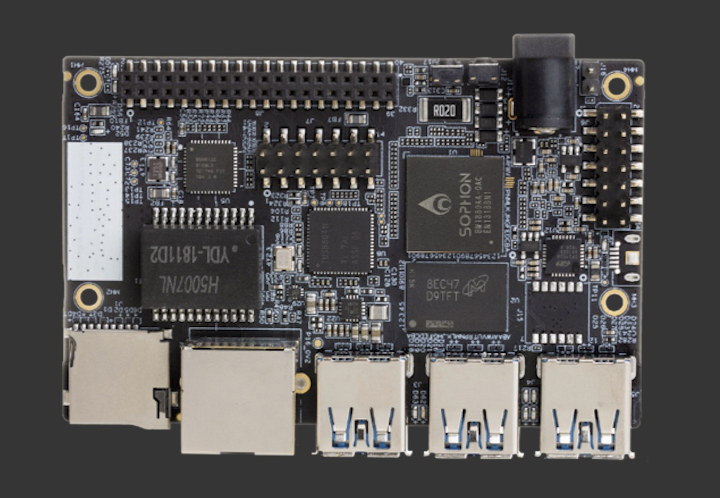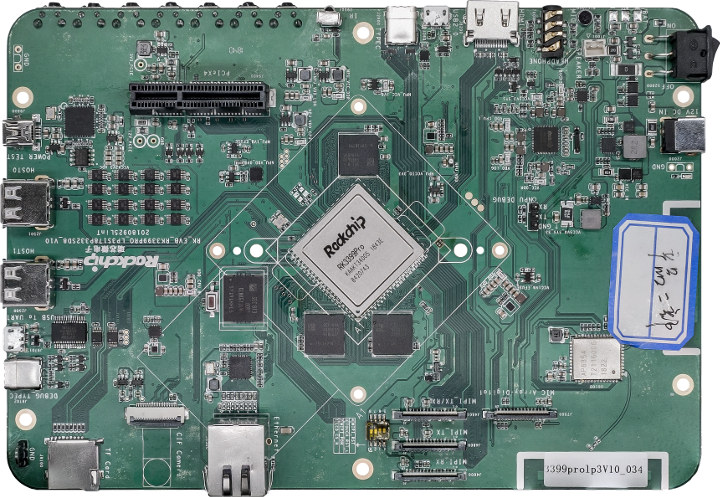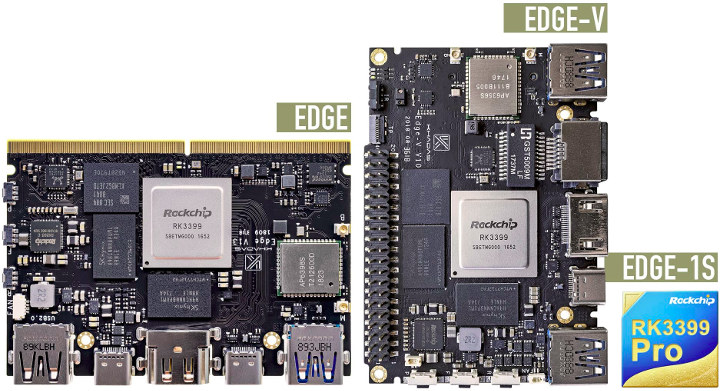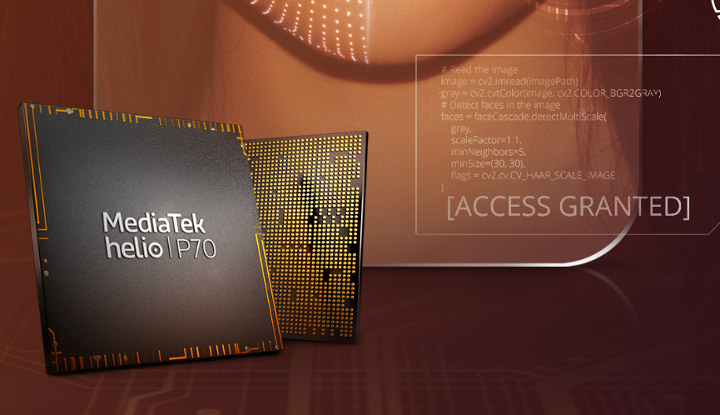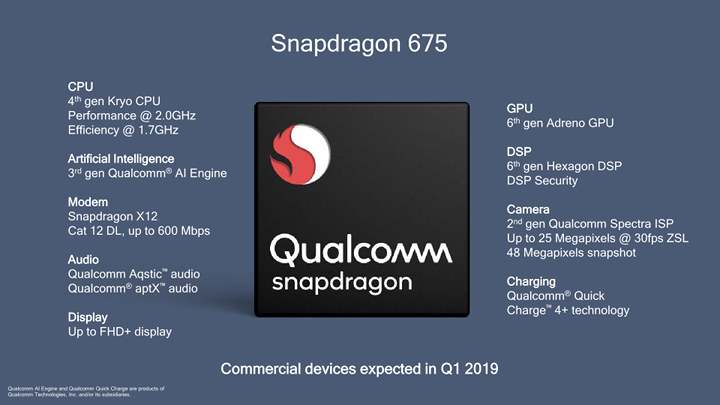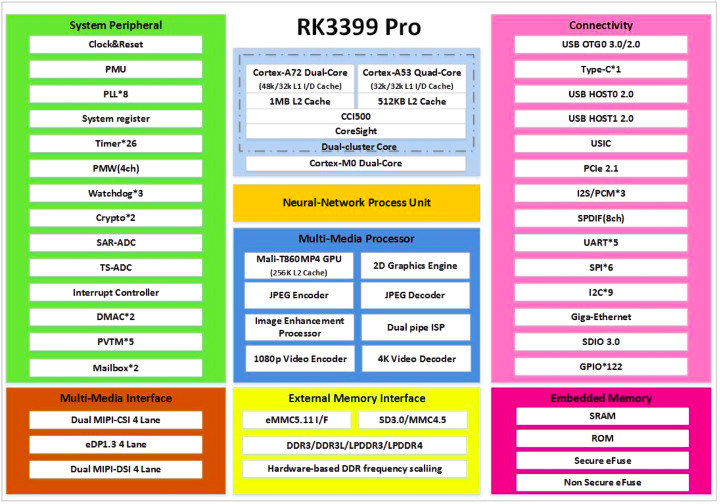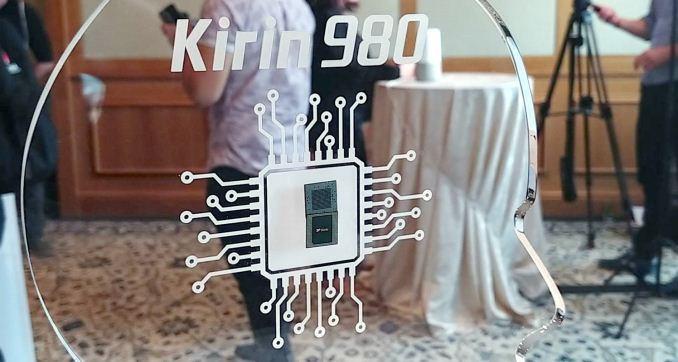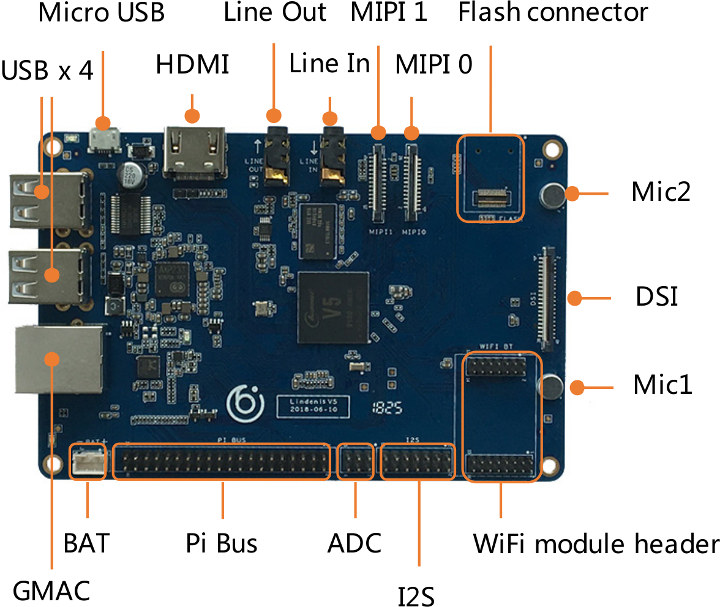Bitmain, a company specializing in cryptocurrency, blockchain, and artificial intelligence (AI) application, has just joined Linaro, and announced the first 96Boards AI platform featuring an ASIC: Sophon BM1880 Edge Development Board, often just referred to as “Sophon Edge”. The board conforms to the 96Boards CE specification, and include two Arm Cortex-A53 cores, a Bitmain Sophon Edge TPU delivering 1 TOPS performance on 8-bit integer operations, USB 3.0 and gigabit Ethernet. Sophon Edge specifications: SoC ASIC – Sophon BM1880 dual core Cortex-A53 processor @ 1.5 GHz, single core RISC-V processor @ 1 GHz, 2MB on-chip RAM, and a TPU (Tensor Processing Unit) that can provide 1TOPS for INT8,and up to 2 TOPs by enabling Winograd convolution acceleration System Memory – 1GB LPDDR4 @ 3200Mhz Storage – 8GB eMMC flash + micro SD card slot Video Processing – H.264 decoder, MJPEG encoder/decoder, 1x 1080p @ 60fps or 2x 1080p @ 30fps H.264 decoder, […]
Rockchip RK3399Pro EVB and NPU Performance Demos (Video)
Rockchip RK3399Pro was announced as an updated version of RK3399 processor with an NPU (Neural Processing Unit) capable of delivering 2.4 TOPS for faster A.I. workloads such as face or object recognition. There haf been some delays in the past because of a redesign of the processor that placed the NPU’s RAM on the PCB instead of on-chip for cost reasons. Eventually we got more details about RK3399Pro, and today I also received a 15-page presentation with some more information about the software, and processor itself. But even more interesting, that’s the first time I see Rockchip’s official RK3399Pro EVB (Evaluation Board), and the guys at Khadas uploaded a video to explain a bit more about the board, and showcase the NPU performance measured up to 3.0 TOPS with an object recognition demo, and an “body feature” detection demo – for the lack of a better word – running in […]
Khadas Edge RK3399/RK3399Pro Board Crowdfunding Campaign Launched
Khadas Edge is another upcoming Rockchip RK3399 board that we initially covered this summer, and comes with a particular design in the sense it is both a single board computer with USB and Ethernet port, and a system-on-module through its edge connector. Later on we found out, the company was working on a variant called Khadas Edge-V with the edge connector being replaced by a more standard 40-pin header, as well as Khadas Edge1S powered by Rockchip RK3399Pro for AI applications. The company has now launched the three boards and accessories through an Indiegogo crowdfunding campaign. I’ve already covered the two RK3399 boards in previous post, and the RK3399Pro based Khadas Edge-1S (2GB RAM, 2x MIPI-CSI, …) will be similar to Edge board but with , so instead I’ll have a closer look at the specifications for Khadas Captain carrier board for Khadas Edge / Edge-1S: Edge connector – 314-pin […]
MediaTek Helio P70 Launched as an Upgrade to Helio P60 Processor
MediaTek Helio P60 processor was introduced earlier this year as one of the first Arm Cortex A73 processors from the company, and also integrated NeuroPilot AI technology for faster or more complex A.I. workloads. The company has now launched an upgrade with Helio P70 that comes with many of the same features combined with incremental performance and power consumption improvements. MediaTek Helio P70 key features and specifications with highlights in bold showing differences over Helio P60: CPU – big.LITTLE octa-core with four Arm Cortex-A73 up 2.1 GHz and four Arm Cortex-A53 up to 2.0 GHz GPU – Arm Mali-G72 MP3 at 900MHz Multi-core AI processing unit (Mobile APU) – 280 GMAC/s; offers deep learning facial recognition, object and scene identification, user behavior-informed performance and other AI and AR application enhancements. System Memory – Up to 8GB, dual-channel LPDDR4x @ 1800 MHz, up to 4GB LPDDR3 @ 933 MHz Storage – […]
Qualcomm Snapdragon 675 Cortex-A76 based Processor Targets High-Tier Mid-Range Smartphones
Last August, Qualcomm unveiled Snapdragon 670 processor with performance and efficiency Kryo 360 cores believed to be based on Cortex-A75 and Cortex-A55 cores, but the company has just announced an update with Snapdragon 675 mobile platform powered by Kryo 460 cores which are based on Arm Cortex-A76 according to Anandtech, and so far, Cortex-A76 was only found in “premium” processors such as HiSilicon Kirin 980. Beside the upgrade cores, the company also claims the processor brings “outstanding gaming, a leap in artificial intelligence (AI) capability and a cutting-edge camera”. Snapdragon 675 main specifications: CPU 2x Kryo 460 (Cortex-A76 based) @ 2.0GHz with 256KB L2 6x Kryo 460 (Cortex-A55 based) @ 1.8GHz with 64KB L2 GPU – Adreno 612 DSP – Hexagon 685, Qualcomm AI Engine Display – Support for FHD+ display Camera – Spectra 250L ISP with triple-camera support Audio – Qualcomm aptX and Aqstic Modem – Snapdragon X12 LTE […]
More Details about Rockchip RK3399Pro SoC, and RK1808 NPU
First announced in January 2018, Rockchip RK3399Pro was supposed to be a pin-to-pin compatible with Rockchip RK3399 processor, and adding a Neural-Network Processing Unit (NPU) capable of delivering 2.4 TOPS for acceleration A.I. workloads. Shortly after Pine64 announced they’d be offering Rockpro64-AI board in August, and later on Vamrs unveils ROCK960 PRO at a Linaro Connect event with an expected Q2 2018 launch. But none of the RK3399Pro boards are available, as there have been delays with RK3399Pro, and some commented an external NPU would be launched first with further details. But today – courtesy of Vamrs – we have some more details about RK3399Pro features, a likely explanation for the delay, and some information about Rockchip RK1808 NPU chip. Contrary to the CES 2018 announcement, Rockchip RK3399Pro will come in a 27x27mm FCBGA1372 package instead of the 22x22mm FCBGA828 package for RK3399. So pin-to-pin compatibility is out of […]
HiSilicon Unveils Kirin 980 Octa-core Cortex A76/A55 Processor with Mali-G76 GPU
Arm announced Cortex A76 CPU core and Mali-G76 GPU in June of this year, and in the past, we normally had to wait about a year between the announcement and the actual launch of SoC with the new IP core. But courtesy of HiSilicon (Huawei), we already know of one Cortex A76 processor with Kirin 980 processor featuring three clusters with two high performance Cortex A76 cores, two Cortex A76 cores clocked at a low frequency, and four Cortex A55 efficiency core. The company also added the new Mali-G76 GPU for good measure. Kirin 980 specifications and key features: CPU (DynamIQ clusters) 2x Cortex A76 cores @ up to 2.60 GHz with 512KB L2 cache 2x Cortex A76 cores @ up to 1.92 GHz with 512KB L2 cache 4x Cortex A55 cores @ 1.80 GHz with 128KB L2 cache 4MB shared L3 cache GPU – ARM Mali-G76MP10 @ 720 MHz […]
Lindenis V5 Allwinner V5 SBC is Designed for AI Video Processing, 4K Encoding
Allwinner V5 V100 is a new quad core Cortex A7 processor targeting 4K 30 fps (Linux) cameras, and integrating AIE intelligent analytic acceleration engine handling motion detection, perimeter defense video diagnosis, and face detection. Usually, it’s pretty hard to get a development board based on a new processor, but Lindenis V5 single board computer based on the processor is already available in China, and comes with 1 to 2GB RAM, HDMI 1.4 and MIPI DSI video outputs, dual MIPI CSI video inputs, Gigabit Ethernet and more. Lindevis V5 SBC specifications: SoC – Allwinner V5 Quad-core Arm Cortex-A7 processor @ up to 1,512 MHz with NEON, VFPv4 FPU 4K @ 30 fps H.265/H.264 encoder and decoder Dual ISP 13M@30fps + 8M@30fps AIE (AI Engine) Architecture – Built-in with intelligent analytics acceleration engine with support for motion detection, perimeter defense, video diagnosis, face detection, flow statistics. Supports binocular depth map. System Memory […]


